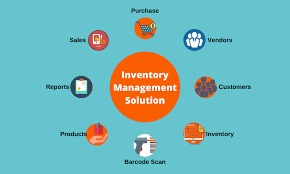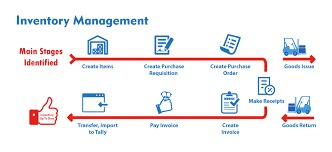6 Min Read


As the global economy continues to struggle with supply difficulties, bottlenecks, and a shortage of goods and materials, the importance of effective inventory management/stock management has never been more apparent.
As we shall see in a moment, a good inventory management strategy focuses on the entirety of the product life cycle. In other words, an inventory management system has a wide range of focus. For example, it starts by purchasing reliable raw materials or finished products from a reliable supplier until that product has been sold to the final customer. Thus, inventory management must also focus on everything between these two points – which includes warehouse management, demand forecasting, distribution, and inventory tracking.
An effective inventory management system can bring plenty of benefits to your business. Apart from maximizing inventory optimization/stock optimization and visibility, effective inventory management can boost overall business productivity and customer retention.
Additional benefits of a sound inventory management strategy include an increase in profit and sales, being able to find a happy balance between the two extremes of overstocking and understocking, decreased waste, and having a solid foundation for business upscaling in the future. Importantly, businesses of any size should have robust inventory/stock management policies – be they small businesses, medium-sized businesses, or large companies.
Let’s now discuss a few of the requirements for effective inventory management and how they can benefit companies.
Requirements for Effective Inventory Management
Insightful Demand Forecasting
Effective inventory management begins with accurate forecasting. Specifically, businesses must anticipate customer demand for a particular stock over a certain period of time. This is necessary to ascertain the amount of stock that they should purchase. There are various demand forecasting methods, including the utilization of past sales records, product seasonality, geographical factors, and the duration of the sales window.
Demand forecasting is greatly aided when companies use inventory management software; these solutions can automatically analyze previous sales seasons and provide estimates for the upcoming season.
Additionally, demand forecasting also assists with determining the level of safety stock needed incase there is an unexpected increase in customer demand. Essentially, you can reduce your inventory costs with the help of software as you can accurately determine the appropriate level of safety stock instead of blindly purchasing stock that your store might never sell.
With accurate forecasting, you can be sure that your company will not be burdened with insufficient or excess inventory, which means that you can get an even better return on your inventory investment!
Up-to-date Inventory Management Software
Inventory management software is critical for two reasons. Firstly, up-to-date inventory management software is essential to provide a platform once your business grows. Insufficient investment in inventory management software will result in businesses spending more time on inventory management/stock management than running their business.
Secondly, inventory software must be paired with other software and technological systems – such as point-of-sales and scanning technology. With these systems integrated, inventory and stock optimization become more straightforward as your company will have real-time inventory tracking capabilities.
Knowledge of Lead Times
Knowing the lead times of your products from your vendors is crucial for successful stock and order management. Generally, the lead time from your suppliers is one factor in determining how many weeks or months in advance your business can order new inventory.
Additionally, as inventory levels deplete or your company begins to eat into its safety stock, lead times indicate when you should order more stock to sell to your customers. In this case, ordering additional raw materials or finished products either too soon or too late can harm company operations.
Holding, Ordering, and Shortage Cost Estimate
Any business must understand the following cost estimates when determining whether they should make a particular inventory investment.
Ordering costs refer to the total costs accrued during the purchasing of inventory. As well as the quantity of stock ordered, ordering costs also include shipping costs, quality control costs, and documentation costs.
A shortage (or deficit) cost estimates lost profits in the case of stock absence. This estimate clarifies why safety stock is needed (and the quantities it is required in).
Finally, holding costs are slightly more complicated. Essentially, every investment into new inventory ties up your capital until it is sold. In the meantime, your business can spend money on other areas besides inventory (such as transportation, building a new plant, and purchasing new equipment), which could be as profitable. Thus, effective inventory management ensures that spending capital on inventory is the best use of a company’s resources instead of spending money on alternative areas.
Inventory Classification System
Inventory classification systems are essential for several reasons.
Firstly, classifying and organizing your inventory using a Stock Keeping Unit (SKU) number assists immensely with inventory tracking (and thus accurate accounting). With a sound inventory classification system, businesses can understand which products are selling quickly to customers and when more products need to be reordered.
Secondly, an inventory classification system is also crucial for handling things like perishable goods. In cases like these, companies can use a ‘first-in-first out’ approach, whereby the oldest stock will be the ‘first out’ of the warehouse, while any new stock received will be sold by businesses later. Of course, such a technique requires an organization to record when stock arrived and where it is located diligently.
Additionally, ‘batch tracking’, another inventory management technique, needs to be supported with a robust classification system. Similar goods are bundled together according to their expiry dates with batch tracking. Again, this calls for a robust management approach and careful recording of expiry dates. An advantage of batch tracking assists with locating defective products and ascertaining the total product return rate. Returning such products to suppliers will be seamless when your stock has been well classified.
Optimized Purchase Order Model
To optimize your purchase order model means having a minimum amount of stock to ensure customers are not left empty-handed; of course, your company must take steps to maintain stock levels as they begin to deplete.
Additionally, to ascertain this minimum level, you will need to do intensive market research and keep an eye on the strategies of potential competitors. Offering a discount on products that have not enjoyed the same success is one strategy to recoup the capital spent on this inventory when you have sold your in-demand products.
Smarter Asset Tracking With NFC Tags
Learn more about how NonStop Suite's NFC Asset Tracking Solution can help your Enterprise streamline operations to new heights.
Get A Free Product Tour
Tips for Managing Inventory
Inventory management is concerned with tracking and monitoring inventory through the entire supply chain. To this end, here are several tips that any business can use to make effective management easier.
Keep Track of Product Information
While it sounds obvious, recording the product information/data is essential for any inventory management inventory strategy. As mentioned earlier, there are several ways to register this data – such as applying an SKU number to your stock. Importantly, all workers should easily understand this number and it should be easy to locate.
Keeping track of your product data/information is essential to identify which products customers are buying quickly. Thus, product information is vital for a better understanding of what your customers want. Furthermore, in the event of product recalling, you can locate the products by using the serial or SKU number, making this a seamless task!
Audit Your Inventory and Keep Track of Sales
Every once in a while, be it after every quarter or mid-way through the year, your business should conduct a physical inventory audit. What matters here is not when your audit is completed but that it is done at a consistent time of year.
Auditing your stock is crucial as it helps your business analyze trends within your stock sales and helps you manage your inventory in the future. This is because stock audits identify instances of overstocking and understocking (which can help save money and increase profit in the future); an audit also helps determine where you should set reorder points for your products.
As mentioned, stock audits help your business manage stock. For example, once you have gained a complete picture of your existing stock, it is easier to make essential business decisions in the future.
Supply Chain Management
At the beginning of this post, we mentioned that supply chain management forms a critical inventory management component. Therefore, if your supply chain is operating inefficiently, your business must address this as soon as possible!
For example, should goods from a particular supplier arrive late constantly (or are damaged continuously), it may be time to look for another provider. Moreover, your supply chain also includes moving goods from warehouse to warehouse and moving goods from your warehouse to a store. Should these logistics operations be slow, costly, or continuously disrupted, it might be time to look at how your organization can solve these problems!
Be Consistent in Your Restocking Techniques
While this tip may seem odd, once you understand how long restocking takes, a consistent and uniform process is necessary.
All staff members should be familiar with the restocking policies of your organization. This includes how to handle fragile goods (in fact, if too many of your goods break, it is time to review this policy) and where goods should be placed. When receiving goods at your warehouse or store, employees should be familiar with offloading and restocking protocols as well.
From the perspective of management or leadership, once you need to re-order more stock, you will be automatically notified. However, before ordering more goods from your vendors, first, check that you will be able to sell them to your customers!
Invest in Latest Technology
Investing in inventory management technology is vital for your business to succeed in the contemporary marketplace. When integrated with artificial intelligence and business intelligence software/technologies, this technology can give your business a solid platform for your inventory management system.
As discussed earlier, your organization should invest in other technological solutions – such as a point of sales solution – and integrate these software solutions. When your technological solutions are integrated in this manner, you will be able to track your sales and your total inventory count no matter where you are!
Wrapping Up!
Should your organization require your inventory management protocols to be revamped, or if you need to introduce inventory management software, you should speak to the NonStop Group.
The NonStop Group has a wealth of experience helping clients in the logistics, transportation, and manufacturing industry. When the NonStop Group helped these clients, their paper-based methods were completely overhauled and replaced by smart solutions. As a result, these companies had total visibility of their assets and saved precious labor hours by eliminating paper forms.
Should you want these results for your company, contact the NonStop Group today!


